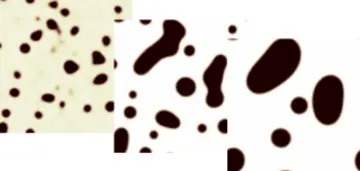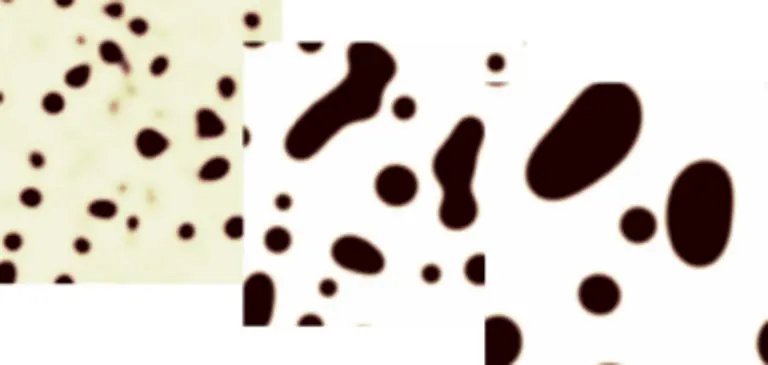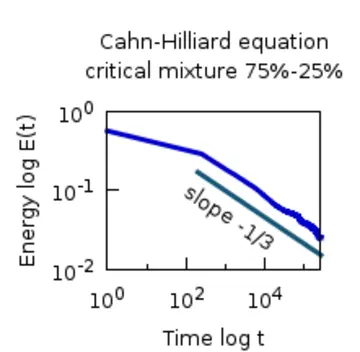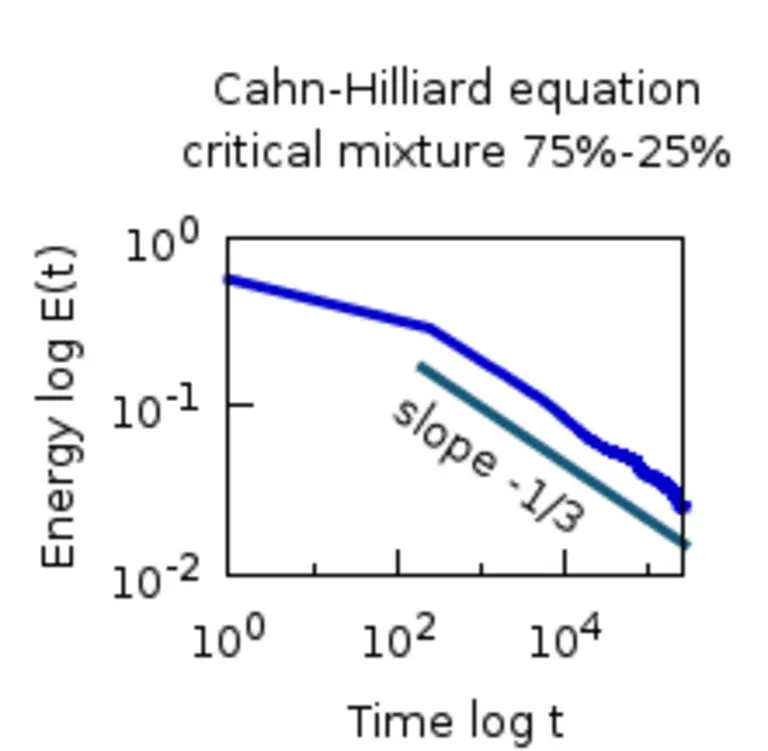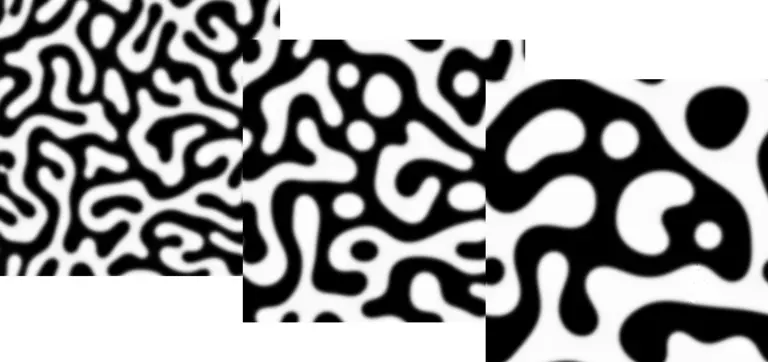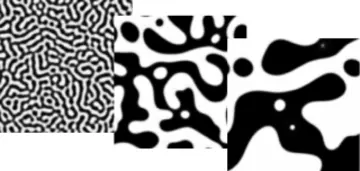
Coarsening
Gradient flow dynamics...
Coarsening dynamics are gradient flow dynamics. This means, the evolution of an out-of-equilibrium system towards relaxation follows the steepest descent in an energy landscape. In many two-phase systems, the energy is proportional to the area of the interfacial layer between these phases. Therefore, descent in an energy landscape corresponds to reduction of the interface - the pattern formed by the two phases "coarsens".
...and scaling laws
The average "size" of the one-phase components reflects the current state of ordering, which increases during the evolution. Despite the possibly complex pattern observed in the coarsening process, experimental and numerical measurements indicate that this characteristic length scale is a simple function of time: Typically, coarsening rates are power laws.
For different models from physics, we study coarsening rates using rigorous mathematical analysis. Our approach is based on the gradient flow structure of the dynamics. Our method translates information on how fast the energy density, i.e. energy normalized by system volume, decreases as a function of (geodesic) distance in the space of configurations into information on how fast the energy density decreases as a function of time. More precisely, we prove time-averaged lower bounds on the energy density. Since the energy is proportional to the interfacial area, the energy density scales like an inverse length, and thus, lower bounds on the energy density can be interpreted as upper bounds on the coarsening rate.
In the following, we illustrate bounds on coarsening rates by means of three examples: diffusion-mediated coarsening, flow-mediated coarsening, and coarsening of droplets on a thin precursor layer.
Example I: Coarsening mediated by diffusion
The physically most intuitive mechanism of rearrangement is diffusion, that is, the cross-motion of unlike particles. Coarsening by diffusion is observed in different systems in physics, like phase separation of metallic alloys, liquids, or polymer mixtures. Usually, the separation process preceeds a quench from a high to a low temperature. In the shallow-quench regime, i.e. temperatures close to some critical value, diffusion takes place through the bulk, i.e. the single-phase domains, whereas in the deep-quench regime, i.e. very low temperatures, diffusion takes place along the interface between the two phases. Mathematically, diffusion-mediated coarsening can be modelled by Cahn-Hilliard equations (fourth-order parabolic equations), where different mobilities reflect the different ways of diffusion: constant mobility corresponds to bulk diffusion and degenerate mobility corresponds to diffusion along the interface.
Depending on the type of diffusion, different coarsening rates are expected: If
Example II: Coarsening mediated by convection
In viscous liquids, e.g. in polymer mixtures, in the shallow quench regime, there is a second rearrangement mechanism besides bulk diffusion: Due to the viscosity of the liquid, particles can additionally be convected by the hydrodynamic bulk flow. The mathematical model that accounts equally for diffusion and convection is a Cahn-Hilliard equation which is coupled to a (stationary) Stokes equation.
It turns out, that in the early stages of phase separation, diffusion is the relevant coarsening mechanism. Accordingly, the coarsening rate is again
Example III: Coarsening of droplets on a thin precursor layer
Some liquids spread on a substrate form droplet configuration on a thin liquid layer. The energy of these configurations is essentially proportional to the surface area of the droplets. Therefore, since the total volume of the droplets remains constant during the evolution, energy decrease is accompanied with coarsening of the droplet pattern. Two coarsening mechanisms are relevant: collapse and collision. Droplet collapse relies on mass exchange from larger to smaller droplets through the precursor layer. This situation is very similar to the Ostwald ripening process observed for diffusion-mediated coarsening in the low-volume fraction regime, as described above: large droplets grow at the expense of small ones which eventually collapse. The basic difference between these two phenomena lies in the mixed dimensionality: Ripening of droplets of a
Heuristics, numerics and experiments suggest that
References
Upper bounds on coarsening rates
In: Communications in mathematical physics, 229 (2002) 3, pp. 375-395Coarsening rates in off-critical mixtures
In: SIAM journal on mathematical analysis, 37 (2006) 6, pp. 1732-1741Upper bounds on coarsening rates in demixing binary viscous liquids
In: SIAM journal on mathematical analysis, 43 (2011) 1, pp. 114-134Crossover of the coarsening rates in demixing of binary viscous liquids
In: Communications in mathematical sciences, 11 (2013) 2, pp. 441-464Coarsening rates for a droplet model : rigorous upper bounds
In: SIAM journal on mathematical analysis, 38 (2006) 2, pp. 503-529Ostwald ripening of droplets : the role of migration
In: European journal of applied mathematics, 20 (2009) 1, pp. 1-67Presentations
- General overview, among others coarsening in spinodal decomposition
(see PDF, 1.3 Mbyte) - Coarsening and Ostwald ripening in spinodal decomposition and for viscous droplets
(see PDF, 0.9 Mbyte)
